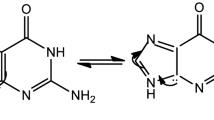Abstract
The effect of three kinds of selenide on Staphylococcus aureus growth was studied by means of microcalorimetry. Differences in their capacities to inhibit the metabolism of this bacterium were observed. The rate constant k (in the log phase) in the presence of the compounds decreased with increasing concentrations of the compounds. The relationship of k and c is nearly linear for the selenium compounds. Judged from the rate constant, k, and the half-inhibitory concentration IC50, the experimental results reveal that the sequence of antibiotic activity of the three tested selenides compounds is (2-hydroxy benzyl imino)ethyl n-hexyl selenide> n-butyl(2-hydroxy benzyl imino)ethyl selenide>bis[(2,4-dihydroxy benzyl imino)ethyl] selenide.
Similar content being viewed by others
References
J. T. Rotruck, A. L. Pope, H. E. Ganther, et al., Selenium: biochemical role as a component of glutathione peroxidation, Science 179, 588–590 (1973).
R. Landenstein, O. Epp, K. Bartels, et al., Structure analysis and molecular model of the selenoenzyme glutathione peroxidase at 2.8 resolution, J. Mol. Biol. 134, 199–218 (1979).
L. Xi, L. Yi, Zh. Ruming, et al., Microclorimetric study of Escherichia coli growth inhibited by the selenomorpholine compounds, Biol. Trace Element Res. 75, 167 (2000)
X. Huibi and H. Kaixun, Chemistry and Biochemistry of Selenium and Its Application in Life Sciences, Huazhong University of Science and Technology Press, Wuhan, China (1994) (in Chinese).
Y. D. Kulkami, A. Rani, A. Bishiioi, et al., Synthesis and characterisation of some new diorganoselenium/tellurium compounds and a comparative study of their antimicrobial activity, J. Indian Chem. Soc. 72, 261 (1995).
G. Buckion, S. J. Russell, and A. E. Beezer, Pharmaceutical calorimetry: a selective review, Thermochim. Acta 193, 195–214 (1991).
S. Hofuer, S. Svenson, and A. E. Beezer. Microcalorimetric studies of the initial interaction between antimycobaterium drugs and Mycobacterium avium, J. Antimicrob. Chemother. 25, 353–359 (1990).
W. Jun, Studies on the synthesis and properties of plant systemic organoselena compounds, PhD thesis, Wuhan University, Wuhan, People’s Republic of China (1998).
X. Changli, T. Houkuan, S. Zhauhua, et al., Microcalorimetric study of bacterial growth, Thermochim. Acta 123, 33–41 (1988).
Author information
Authors and Affiliations
Rights and permissions
About this article
Cite this article
Liang, H., Wu, J., Liu, Y. et al. Kinetics of the action of three selenides on Staphylococcus aureus growth as studied by microcalorimetry. Biol Trace Elem Res 92, 181–187 (2003). https://doi.org/10.1385/BTER:92:2:181
Received:
Accepted:
Issue Date:
DOI: https://doi.org/10.1385/BTER:92:2:181




